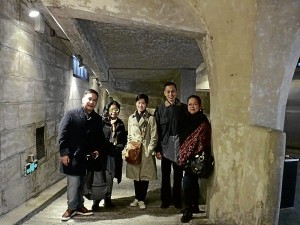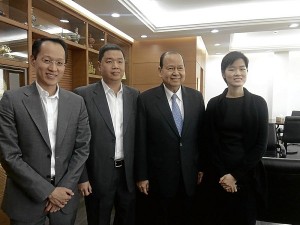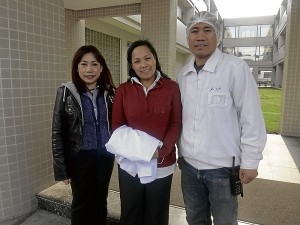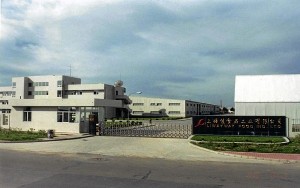In a gentrified section of Shanghai, we were about to begin our tour of the restored 1930s house—now a living museum open to the public—when Carlson Chan espied one of the artifacts on display. It was a wooden chamber pot. He pointed it out to us. We gathered around it, curious about this remnant of China’s pre-Communist past.
“The neighbor of our factory at that time was still using something similar to this,” he said, referring to the early ’90s. “Our neighbor would unload its contents and use it as fertilizer.”
“Really?” we said, almost in disbelief. “That must have been quite a stink. And in the ’90s?”
“Yes, as recent as that,” he replied.
Carlson was trying to make a point on how Shanghai was a totally different world as recently as the ’90s, so vastly removed from the cosmopolitan and utterly sophisticated Shanghai that the world is racing to inhabit and do business in today.
This reinvented section, a popular destination in Shanghai known as Xintiandi, now has chic boutiques (e.g. Shanghai Tang) and restaurants (e.g. YeShanghai). The house we just toured had been reconstructed to typify the Shikumen architecture of the early 20th-century Shanghai.

CARLSON Chan and sister Shera Tiu (second and third from right) tour their Manila visitors in the 1933 Shanghai Abbattoir which has been transformed into a contemporary building of chic specialty shops, cafés and restaurants. They are, from left, Pen Roque, Jessica Zafra and Annie Ringor. TAKEN WITH SONY CYBERSHOT Loosely translated, Shikumen refers to a “stone gate,” which was what homes in the ’20s and ’30s had in Shanghai. Beyond the stone gate was a big home with a courtyard, a foyer and living areas, bedrooms, kitchen, to accommodate either a big clan or transients trying to eke out a living in Shanghai, including artists.
It reminded me of our own “ilustrado” homes at the turn of the century. Like ours, the Shikumen also has a mezzanine room—a room on the landing between two flights of stairs—which a transient, usually a struggling artist, could rent. It was in a Shikumen that many of Shanghai’s famous writers once lived.
Our imagination, however, was stirred not only by the big cosmopolitan Shanghai but in a more micro setting, by the living and work conditions Carlson’s family and their staff must have had to contend with when they started their snack food business in 1993, when China had just opened its door to foreign investors.
To us, that vintage chamber pot said it all; it became a graphic representation of the daunting venture the Chans went into, and from there, we could only appreciate the hardy stuff such an entrepreneurial family is made of.
Just an hour earlier, over dinner, the family patriarch, Carlos Chan, recalled—with some coaxing from us, because this man apparently doesn’t like to talk about himself—how, in those early years, he would take near-empty flights to Shanghai to start up his business.
The bloodshed at Tiananmen Square was still fresh in the world’s mind, and few businessmen dared venture out into China. Chan was among the few. And with a little comic tone to the nostalgia, he recalled how he had preferred daytime flights because he feared an evening landing in Shanghai airport in the dark night. The conditions in China were that crude and backward.
It was as if, when nobody was looking and when only a few dared, Carlos Chan saw the vast (an understatement) market that would be China. And he has always loved Shanghai.

LARRY CHAN: “Today’s industry faces the challenge of creativity.” Actually Carlos Chan had been visiting Fujian, his ancestors’ homeland, and Shanghai since the ’80s, waiting for the doors to open and establishing contacts with local officials and “businessmen” (if you could call the unofficial capitalists, that, in the bastion of Communism).
Taking the cue
When Deng Xiao Ping began instituting economic reforms and when Shanghai instituted those liberal reforms in ways that would be accommodating to foreign investors, Chan took the cue, started bringing in the snack foods produced by his factory in the Philippines, and took over a state-owned factory and its 300 employees.
He entered into what was considered then as a “cooperative venture”—with him as investor, and China providing the plant and employees. So determined and single-minded was he to manufacture and sell snack foods to the Chinese market that he asked his eldest son Carlson to live in Shanghai to help set up the factory. Carlson lived and worked in Shanghai for 14 years; he resettled back in Manila only a few years ago.
Carlson would be followed by Chan’s younger sons Larry and Archie. Larry recalled how, after high school graduation and working for a Management Engineering degree at the Ateneo de Manila University, he was already told by his father—“You’re going to Shanghai.”
Today, Oishi, the snack food brand of the Chans, is one of the biggest food brands in China, where it is also known as Shanghaojia (which means “up and good”). It has 14 factories in 10 provinces in China, including one that’s at the border of Kazakhstan. Its main factory is on a 17-hectare sprawl in Shanghai, still smaller than Oishi’s 40-hectare compound in Cavite.
Oishi is also in Vietnam, where it is the market leader, in Myanmar, Thailand, and Indonesia—the latter two since 2006—in India since 2011, and Cambodia in 2012.

CARLOS CHAN (second from right) with his children, from left, Larry, Archie and Shera That a Chinese-Filipino firm is a market leader in the world’s ultimate marketplace that is China isn’t so well-known among the Filipinos. We’ve heard about how big Oishi is in China, but could only imagine the feat—until last week, when we were invited by the Chans to Shanghai. It was a most informative experience that somehow left us feeling proud—because it was no modest achievement.
Established in 1975, Oishi now has snack food products which can be considered iconic. Apart from the early bestsellers Oishi Prawn Crackers, Kirei Yummy Flakes, there are the Bread Pan (a favorite of the A-list party hostesses in the Philippines), Marty’s vegetarian chicharon (a winner of a lifestyle product, so now), Ribbed Cracklings in Salt and Vinegar, Potato Fries, Pillows (chocolate crackers resembling tiny pillows), and recently, Smart C+ (the ready-to-drink vitamin C, which is claimed to have neither added preservatives, artificial sweeteners nor coloring).
In China, on top of these products, Oishi has candies and fruit juices. Its soft candies (in vanilla and other fruity flavors) beat the White Rabbit of your childhood—a pity they’re not sold here.
Indeed, in China and in many parts of Asia, Oishi has evolved into a lifestyle brand.
Feel-good story
That the brand has its origins in the Philippines and that it is owned by a Chinese-Filipino is a source of pride. Oishi is not only a success story, it is also a feel-good story.
And yet Carlos Chan, who’s now 71 years old and claims he’s happily retired, makes it sound as if his feat were the most casual in the world.
“Suwerte lang,” he said over our dinner at YeShanghai last Saturday. “We just got lucky.”
Perhaps, but luck is just one of the brushstrokes in this interesting portrait.

FILIPINO EXPERTISE is tapped in Oishi research/development in China: Carmela Dujali, Nilo and Teresita Ortiz You don’t have to be an MBA-holder to note that Carlos Chan’s master stroke is his strong gut feel—that, and the courage to take a risk. To penetrate the one-billion rich (in the ’90s) Chinese market, Chan invested $3.5 million in a factory and food technology in China.
“Even if China was poor then, surely the poor could afford even 50 cents or 1 yuan for snack food, I thought,” Carlos Chan recalled his optimism about the market.
“You can say we exported our R and D (research and development) and our snack food-manufacturing experiences to China, from the Philippines,” recalled Larry, who’s now the chairman of the company. (Carlos Chan is chairman emeritus.)
This advancement in product development would also include the “transfat” mind-set evolving in the snack food market.
At the onset, apart from the capital and technology, Oishi had a competitive edge over other Filipino firms (in snack food, particularly) trying to crack the Chinese market. “Pinadala ko sila (I sent them) to live here,” Carlos Chan said, pointing to his sons seated around our dinner table.
Sons Carlson, Larry and Archie based themselves in Shanghai—and worked as hard, if not harder, than the rest of the company staff and workers. At one point or another, they would live in the company dormitories, then staff houses, and worked the whole process of the business, from production to distribution and delivery. (Larry and Archie continue to be based in Shanghai, with their respective families.)
On our tour of the dry goods market, the sight of motorcycles triggered something in Carlson. With a remaining sense of wonder and a bit of nostalgia, he remembered how, in their start-up days, such a small motorcycle could load up to 40 cartons of Oishi snack food for delivery to the market.

ENTRANCE to the 17-hectare Oishi factory in Shanghai Listening to him, one imagined the physical transport of snack foods to the countless dry-goods markets and sari-sari stores in Shanghai. Rudimentary beginnings, indeed. Now the Oishi network has more than 550 distributors and 150 direct retail customers all over China.
Chan had his first return on investment in 1994, or only a year after he made the investment.
Willy Wonka
A tour of the Oishi plant in Shanghai, with the iconic logo of the Oishi bird greeting you everywhere, was like a trip to a Willy Wonka chocolate factory, like in the movie—a rich multi-sensory experience. Each product variant, from the prawn crackers to the potato fries and candies, had its own assembly line or production terminal, from the raw ingredients to the packaging.
Archie Chan, the second eldest son who shifted from Architecture at UST to Engineering degree at De La Salle, is on top of R&D, and inherently loves machines. His father knew he was a natural choice to head production and product development. He toured us around the various assembly lines, showing and letting us hold the “pellets” that would be processed into prawn crackers, or the potato skins going through the machine that squeezes out the fats, or the fresh shrimps to be processed.
As you walked from one section of the plant to another, your nose was being pampered by a succession of scents and aromas, from the lemony and the fruity to the sugary and the piquant. Archie loves food, by the way, and he marries this with his passion for technology.
Younger son Larry talked about how, in this new century, the food manufacturing business would face the challenge of creativity—how technology and human imagination would blend “to change the mind-set of people when it comes to snack food. It is no longer junk food, with ingredients having to carry nutrition and health.”
He added, “We don’t limit experiences when it comes to the food’s tastes.”
Indeed, how lucky could a father get—to have children with versatile passions and interests, and enabling these multi-disciplines to blend into one solid business venture.
Carlson, a diehard cineaste (his taste runs the gamut of Hollywood, Chinese and Filipino films to the classics and the indies), is obviously into the arts and letters, but nonetheless could pursue business goals with ascetic discipline. Archie is into food and technology. Larry is into the broad business vision.
The daughters Ringby and Shera are into other facets of the business, such as marketing and communication. The youngest son, Oszen, is president of Contemporain Foods, Inc. in the Philippines. Isn’t it obvious how the first letters of the names of his children are taken from the father’s name?
How does a father like himself make his children work as one, when, as everyone knows, a business empire isn’t naturally carried through generations? “I gave them responsibilities,” said Carlos, making it sound so easy.
Archie noted how their father made it a point to bring them on his travels and to show them how it’s done in the world. “When you are properly compensated and you enjoy what you’re doing, it’s not hard to stay in the family business,” he said.
And it helped, Larry said, that they grew up “with a cabinet always reserved for snack foods.”
Carlson was pretty candid. “Honestly, it never crossed our minds to work anywhere else but in the family business, perhaps because we really found it fulfilling.”
The younger Shera was more specific: “Most likely because it’s quite dynamic. There’s always something going on somewhere, like today it’s Vietnam or Myanmar.”
Oishi the global brand is the child, quite literally, of Liwayway Gawgaw, the post-World War II brand started by the parents of Carlos. In 1946, Chan Lib, a Chinese migrant from Fujian (he was 14 when he migrated long before Liberation), and his wife See Ying opened a repackaging business they would call “Liwayway” (break of dawn, in Filipino).
They bought products such as coffee and starch from wholesalers, and repackaged these in sizes for consumers who had just survived the war. In time, Liwayway Gawgaw became a household brand for generations.
Today, the Oishi brand is under the umbrella firm Liwayway Group of Companies.
In 1974, Liwayway ventured into snack food manufacturing and created “Oishi”—delicious or beautiful, in Japanese—to denote the Japanese technology used in their production.
Carlos is the eldest in the brood of eight. Brother Manuel opened the snack food manufacturing business which, in the late ’70s, he would turn over to Carlos. Youngest son Ben—the “baby” in the family and “apple of their eye”—would be Ben Chan, the fashion retail icon whose Bench would be a landmark in Philippine retail and fashion.
Carlos was an Architecture student at Mapua Institute of Technology when he decided to quit college and work full-time in the family business. Today, relishing the fact that he’s 71, retired, and thus entitled to play golf, he said he just wants “enjoy life’s simple pleasures.”
In the Shanghai World Expo of 2010, visitors to the Philippine Pavilion expressed surprise as they saw Oishi products on display—until then they didn’t know that China’s major snack food brand was as Pinoy as adobo.
In product development Oishi has brand champions, even among the Chan family members, with each one batting for the snack food one loves. Carlos Chan is brand champion for marshmallows and soft candies.
Marshmallows—that’s how life’s simple pleasure is turned into pioneering business.















































